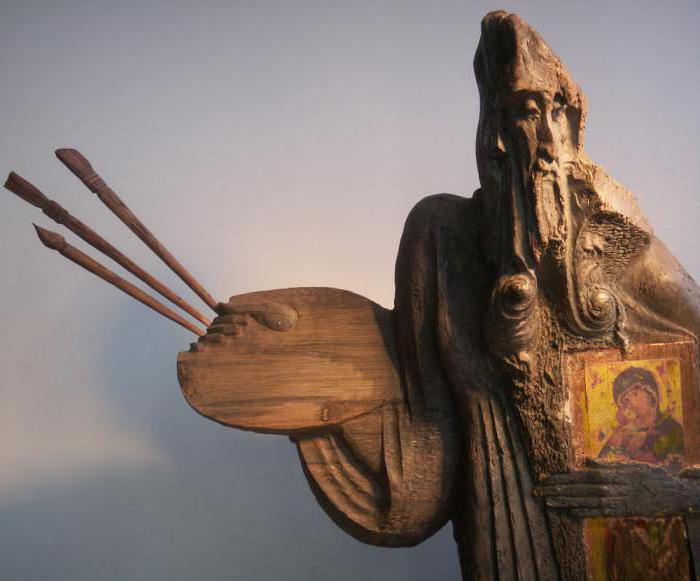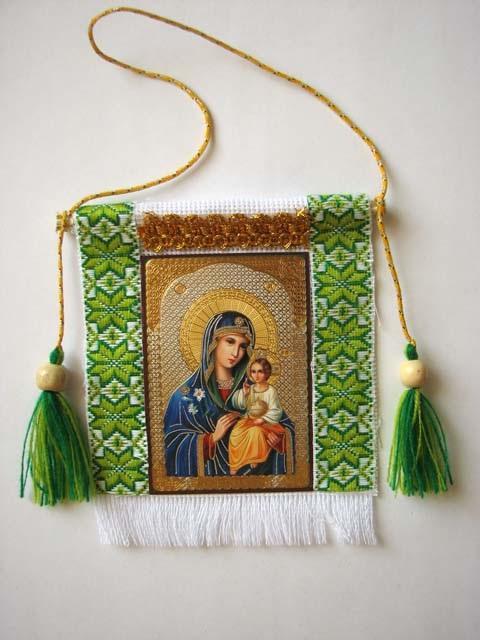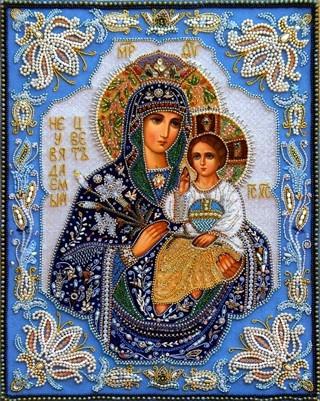Theophanes the Greek: icon "Our Lady of Don"
In 1370 he came from Byzantium and settled inNovgorod is a thirty-year-old icon painter named Theophanes. The Novgorodians gave him the nickname Greek - it was similar at the place of birth, and the Russian words were always confused with the Greek words with the Greek words. When, by blessing, he began painting the Transfiguration Church, which was on Ilyin Street, he showed such marvelous images of the Eternal Forces to the astonished eyes of Novgorodians that glory which had not faded to this day was fixed to him.
Icon painter from the banks of the Bosphorus
About the life of Theophanes the Greek, little information has been preserved. It is known that from Volkhov he went to the Volga to Nizhny Novgorod, and then to Kolomna and Serpukhov, until finally he settled in Moscow. But everywhere, wherever he directed the foot, he left after himself the miraculously painted temples, screensavers in church books and icons, which became an unattainable model for many generations of artists.

Despite the fact that since the time when he lived and workedTheophanes the Greek, passed six centuries, many of his works have survived to this day. This is the painting of the already mentioned Novgorod church of the Transfiguration of the Savior, and frescoes on the walls of the Kremlin cathedrals - Arkhangelsk and Blagoveshchensk, as well as the Church of the Nativity of the Virgin in the Saints. But other than that, the icons painted by his brush entered the treasury of Russian art, the most famous of which is the image of the Most-Pure Mother of God, which went down in history as "Our Lady of Don".
A gift to Prince Dmitry Donskoi
On the history of the creation of this most famous workthe master preserved so little information that among art historians there are a variety of opinions about the year and place of its writing. There are even skeptics who try to challenge the authorship of Theophanes (in their opinion, one of his disciples painted a holy face). However, for a long time there was a tradition, equally based on historical materials, and on the oral tradition, according to which it was Theophanes the Greek who created this masterpiece, and did it until 1380.
Why so? The answer can be found in the "Historical Description of the Moscow Donskoy Monastery," compiled in 1865 by the famous historian IE Zabelin. On his pages the author cites an ancient manuscript, which tells how before the start of the Battle of Kulikovo, the Cossacks presented to Grand Duke Dmitri Donskoi this image of the Blessed Virgin Mary, through which the Queen of Heaven herself bestowed strength and courage upon the Orthodox forces to overcome adversaries.

About where the Don Icon of the Mother of God wasAfter the defeat of Mamai on the Kulikovo field in 1380, there are several hypotheses. The most likely to be considered the one according to which the holy image for two hundred and seventy years was kept in the Assumption Cathedral of the Simonov Monastery, for which it allegedly was written. This is not accidental, since the icon is two-sided, and on its back is written the scene of the Assumption of the Mother of God in the compositional decision generally accepted by the Orthodox Church.
Icon - the defender of Russians
The next bright phenomenon of the icon, which was receivedDmitry Donskoy before the Battle of Kulikovo, refers to 1552, when, going to his victorious campaign against the Kazan Khanate, before this icon, Tsar Ivan the Terrible prayed. Asked from Heavenly Intercessor Her patronage, he took with him and the image written by Theophanes the Greek, and after returning, he placed it in the Archangel Cathedral of the Kremlin. The icon was accompanied by the tsar and in his campaign to Polotsk in 1563.
It was so pleasing to the Queen of Heaven thatthe miraculous image of Our Lady of the Don appeared before the Russians in the time of heavy military trials, instilling in them the courage and blessing of the Orthodox army. It happened in 1591, when countless hordes of the Tatar khan Kazy II Girey came to the Mother See. Already from the height of Vorobyovy Gory they looked with predatory gazes at the Russian capital, but Muscovites from the cathedral carried the Don icon of the Mother of God, the city walls bypassed it, and they became inaccessible to the enemy.
The next day, August 19, in a terrible sectionthe army of the Tatar khan fell, and he himself, with the remnants of his henchmen, barely escaped, and only miraculously returned to the Crimea. All this time the Don icon of the Mother of God was in the regimental church, and no one doubted that it was her intercession that helped to drive the enemies from the Russian land.
In memory of the great victory on the spot, wherewas during the battle regimental church, founded a monastery, called the Don. For this new monastery a list was made of a miraculous icon that gave it its name, and the day of its all-church celebration was set on August 19 (September 1). Since that time the Virgin of Don has been revered as the heavenly defender of the Russian land from all who come to her with a sword.

King, hostage of the Time of Troubles
When in 1589, after the death of King FyodorIoannovich - the third son of Ivan the Terrible, the dynasty of the Rurik people broke in Russia, and Boris Godunov got the empty throne, then the first Patriarch of Moscow and All Russia, Job, blessed him for the kingdom with this icon. However, Boris's rule was not happy. It coincided with the hardest period of Russian history, which was called the Time of Troubles.
After seven years at the head of the state,torn both by foreign intervention and internal social conflicts, the tsar suddenly died in 1605, barely surviving to fifty-three years. The Archangel Cathedral of the Kremlin became the place of rest for the deceased sovereign, where the face of the Donskoy Icon of the Mother of God was mourning on his gravestone from the wall, before which he had sworn, in spite of the incessant ringing of the bells, in selfless loyalty to the Fatherland.
The beginning of the reign of Peter I
It is known that at the beginning of the reign of Peter IRussia waged a war with Turkey, which lasted for fourteen years and became part of the Pan-European Great Turkish War. It began with the campaign of the Russian army to the Crimea. Headed by her faithful associate of the prince, Prince Vasily Vasilyevich Golitsyn.
The icon "Our Lady of Don" accompanied him inthe whole period of this military campaign, which became a hard test for Russia and costed her numerous victims. But the intercession of the Virgin, revealed to her through the image, kept in the tent of the commander-in-chief, helped the warriors, albeit with great losses, but to return home, having fulfilled the task assigned to them by allied commitments. The last years of the 17th century were performed by the princess Natalia Alekseyevna in the chambers of Peter the Great's own sister, where many old icons were collected, and from where it was later transferred to the Annunciation Cathedral of the Kremlin.
The fate of the image in the XVIII and XIX centuries.
In the XVIII and XIX centuries, the icon usedpopular veneration. She was offered prayers and wrote praiseworthy words. In addition, the illustrious image was at the center of many novels and legends, some of which reflected actual events, information about which was obtained from documentary sources, and some were the product of the imagination of the people, who wanted to express their love and gratitude to the Heavenly Intercessor.

To decorate the icon did not spare the means. It is known that before the Napoleonic invasion the image was covered with a rich salary with precious stones. The stones were stolen by the French, and after their expulsion there was only a golden frame for the icon, which the marauders mistakenly mistook for copper.
Artistic features of the icon
It is written on a board measuring 86x68 cm. Speaking about the iconographic features of the image, it should be noted that the icon "Don Mother of God" refers to the type of the Holy Mother of God "Umilenie", adopted by art historians, whose characteristic feature is the union of the faces of the Virgin and Her Eternal Infant. But the theological meaning, embodied in the icons of this type, goes far beyond the everyday scenes depicting the caress of the mother and her child.
In this case the visual expression is presentedreligious dogma, which determines the relationship of the Creator to His creation. The Scriptures speak of God's so unlimited love for people, that for their salvation from eternal death He sacrificed His only-begotten Son.
Particular solemnity to the figures attachedThe now lost golden background, on which the Virgin and Child were depicted. The gilding that covered the haloes was not preserved, but, fortunately, the faces and clothes have reached our days in good condition.
Compositional and color solution of the icon
A composite image solution is sufficientis characteristic of the icons of this derivation (the canonical variety). The Blessed Virgin embraces the Son, who is sitting on Her lap and clinging to Her cheek. The Eternal Infant is depicted as having lifted up his right hand in a blessing gesture, and in his left hand holding a scroll.
The icon of Theophanes the Greek differs from other imagesgiven by the depiction of the naked legs of the God-child, naked to the knee, leaning on the wrist of the left hand of the Virgin. The folds that cover His chiton of ocher color - the outer clothing, are underlined by a network of thinly worked gold lines, creating in combination with the color of the fabric and the blue inserts a solemn and festive look. The overall impression is complemented by a golden lace, pulling the scroll.

Equally elegant and at the same time with a shadeNobility represents the vesture of the Virgin. Her upper cloak - maforium - is made in dark cherry tones and trimmed with a gold fringe trimmed with fringe. Three gold stars, traditionally serving as decoration for Her decoration, have a purely dogmatic meaning. They symbolize the eternal virginity of the Mother of God - before, during and after the birth of Jesus.
Deviations from Byzantine canons
It should be noted that, in the opinion of the majorityart historians, icon painter Theophanes the Greek (Byzantine in origin) in his work went beyond the established traditions of the Constantinople school, whose masters did not allow themselves to violate the established canons in creative experiments. The Don icon of the Mother of God is a vivid example.
To give the face of the Virgin a largevitality and expression, the artist admits some asymmetry in the location of the mouth and eyes. They are not parallel, as in the icons of the Byzantine masters, but are located on the descending axes. In addition, the mouth is slightly displaced to the right.
These seemingly insignificant details,used by the author for purely technical purposes, were, nevertheless, a violation of the canons established by the Constantinople church, and in Byzantium were considered unacceptable. And there are many such examples in the icons and frescos that Theophanes the Greek wrote. "The Virgin of Don" is one of them.
Back of the icon
Of great interest is the downsideboard, which depicts the Assumption of the Virgin - the icon, as mentioned above, is two-sided. Painting here is much better preserved than on the face. Even a thin inscription written by a cinnabar is clearly read. Perhaps, the former salary on the icon, stolen by the French in 1812, played a role, as a reminder of which only the gold frame for the icon that has survived to this day serves.
When looking at the image, the absenceelements traditional for the given plot. The master did not include in the composition the usual image of angels, apostles, mourning women, and many other similar attributes. Central is the figure of Jesus Christ holding in his hands a tiny swaddled figure symbolizing the immortal soul of the Mother of God.

Before the figure of Christ on a bed resting bodythe deceased Virgin, surrounded by the figures of the twelve apostles and the two bishops who were present, according to the Holy Scriptures, at the demise of the Virgin Mary. Characteristic are two details, which are an expression of the conventions adopted in icon painting: these are the buildings placed at the edges of the icon and meaning that this scene takes place inside the room, and the candle placed before the bed of the Virgin is a symbol of a fading life.
Discussions around the authorship of the icon
It is characteristic that the scene depicted inback side of the icon, bears in itself obvious deviations from the traditions of Byzantine painting. This is primarily evidenced by the faces of the apostles, devoid of the typical features of the traditions of Constantinople, the features of aristocracy. As many researchers of Theophanes the Greek emphasize in their works, they are more characteristic of purely peasant features, common among the common people.
Not surprisingly, multiple differencesworks of Theophanes the Greek from the canons and artistic traditions of Byzantium gave rise to a number of art critics questioning the authorship of the works attributed to him. Their point of view is quite understandable, because on the banks of the Bosphorus the artist was not only born, but also formed as a master of icon painting - we should not forget that he came to Russia at the age of thirty.
His manner of writing is closer to the Novgorod school thanhis native Byzantine. Many years of discussion on this issue continue to this day, but they are dominated by the view that, having found themselves in a new country for him and having the opportunity to see many old icons created by Russian masters, the artist used in his work their characteristic features.
The most famous copies of the icon
It is known that throughout the centuries-old historyicon with it was made several lists. The earliest of these dates back to the late 14th century. It was made by order of the cousin Dmitry Donskoy - Prince Vladimir Andreevich, and, adorned with a silver gilt salary, became his gift to the Trinity-St. Sergius Lavra.
At the time of Ivan the Terrible at his command weretwo lists were made, one of which, sent to Kolomna, was subsequently lost, and the other, which was placed in the Assumption Cathedral, has survived to this day. When the Intercession of Heaven in 1591 helped Muscovites repel the invasion of Khan Giray, and on the site where the regimental church stood, the Don monastery was founded, another list of the miraculous image was specially made for him. Several copies of a later period are also known.

Donskoi Monastery: address and transportation by public transport
The Soviet period was a new stage in historyDon icon of the Mother of God. Since 1919, this image is included in the collection of the Tretyakov Gallery. Here it is one of the most remarkable exhibits of the section of Old Russian painting. Once a year, on the day of his all-church celebration, the image is delivered to the Donskoy Monastery (address: Moscow, Donskaya sq. 1-3), where a solemn divine service is held before him, to which thousands of people gather. Everyone who, while at this time in Moscow, wants to take part in it, can get to the monastery, leaving the metro station Shabolovskaya.
It is not by chance that this image of the Blessed Virgin MaryIt enjoys special love among Russians. As noted above, he throughout his entire history was associated with the military exploits of the defenders of the Fatherland, and through him the Queen of Heaven repeatedly showed her help and intercession to the Orthodox people.
</ p>




